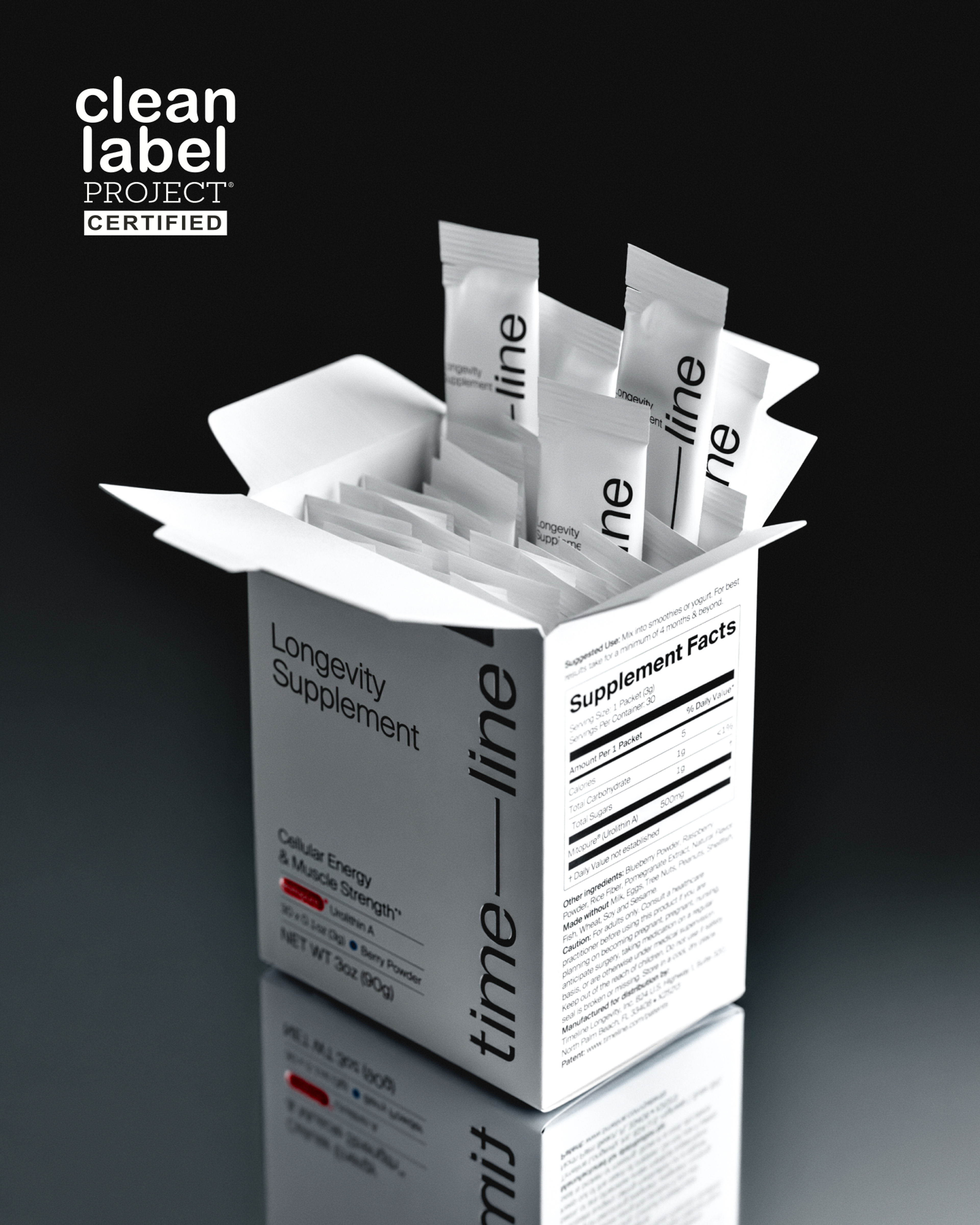Postbiotics: The gut-mitochondria axis
Over the past few decades, much research has been devoted to understanding the gut microbiome and its influence on human health...

Over the past few decades, much research has been devoted to understanding the gut microbiome and its influence on human health. Over 100 trillion microbial cells reside in our intestinal tract, offering several benefits, including protection from pathogens and supporting gastrointestinal, metabolic, and immune health.[1] Our microbiome consists of bacteria, yeast, fungi, viruses, and archaea, which thrive in this nutrient-rich environment[2]. Our bodies provide these “bugs” room and board, and in return, we receive important health advantages. While it is generally accepted that there is a "core" population of microbes that populate the human GI tract, each of us has our own unique microbiotic fingerprint that is based on factors including our age, the environment we live in, antibiotic use, whether we were born by C-section or breastfed, our diet, and our general state of health.[3]
At this point in time, most of us are familiar with probiotics, the microbes that commensally live in our digestive tract. If you’re gut health savvy, you may even be familiar with prebiotics, the fuel source utilized by these microorganisms. Postbiotics, however, may be foreign to many as they are the new kid on the block in the field of digestive health. They have the potential to be a significant player in human health, so let’s spend some time getting to know them.
Defining the “-biotics”
It can be easy to confuse the terms pre-, pro- and postbiotic as they are very similar sounding; however, their role and function could not be more distinct.

Graphic illustration of probiotic organisms
- Probiotics are living microorganisms that deliver health benefits when consumed in an appropriate dose.[4] We consume probiotics in fermented foods such as yogurt, kimchi, sauerkraut, and kombucha or take them in supplement form. Much research has been devoted to the community of microbes that live in our digestive tract and the health benefits they confer on us. Since imbalances in the composition of the gut microbiome have been linked to several diseases, including irritable bowel syndrome, certain types of cancer, obesity, and type 2 diabetes[5], attention is being given to using probiotics to mitigate disease risk. Interestingly, it appears that our microbiome changes through our life cycle and that these age-related changes are beneficial to our health and longevity.[6]

Graphic illustration of prebiotic foods
- Prebiotics are essentially a food source for the health-promoting microbes in our gut, allowing them to create metabolic end-products that support human health.[7] Nondigestible carbohydrates, including certain types of starches and fibers, pass through the digestive tract intact, where the microbiome ferments them.[8] Prebiotic-rich sources are mostly fibers and include foods such as onion and garlic, asparagus, Jerusalem artichoke, chicory, and banana. Polyphenols can also act as prebiotics. They are compounds responsible for the bright color seen in many fruits, veggies, grains, and spices that we regularly eat. Coffee, tea, and dark chocolate are also rich sources of polyphenols.

Graphic illustration of postbiotic compounds
- Postbiotics are aptly named as they are formed after (or post) the metabolism of prebiotic compounds by the gut microbiome. These metabolites (or active substances) are becoming familiar to the general public as research brings to light their health benefits. The International Scientific Association of Probiotics and Prebiotics (ISAPP) defines a postbiotic as a “preparation of inanimate microorganisms and/or their components that confers a health benefit on the host.”[9] More simply put, our microbiome takes properties from the food we eat (i.e., fiber and polyphenols) and converts them to substances we need to thrive. These substances are called postbiotics.[10]
Exploring the benefits of postbiotics
Several distinct postbiotic compounds have been identified, including short-chain fatty acids (SCFAs), vitamins, polysaccharides, proteins, and lipids, each exerting its own beneficial effect. While researchers are still discovering the many ways postbiotics impact our health, the following benefits have been well documented.
- Improved digestion - SCFAs, including butyrate, propionate, and acetate, are produced by fiber fermentation in the colon. They are an important source of energy for the cells of the digestive tract and therefore play a crucial role in the turnover and renewal of the intestinal lining. Postbiotics may help preserve the integrity of the intestinal barrier, making them helpful in treating inflammatory bowel disease and other digestive disorders.
- Support the immune system - some types of postbiotics appear to interact with the cells of the immune system. Specifically, 𝞫-glucans may support the cellular response to pathogens like parasites, bacteria, and viruses. Other postbiotics offer protection from infection by helping to seal off the gut lining.
- Additional benefits - the impact of postbiotics is far-reaching. Their usefulness is being studied for cancer prevention, cholesterol management, allergy treatment, alleviating food sensitivities, and modulating the gut-brain axis, to name a few.[11]
Postbiotics and the gut-mitochondria axis
Polyphenolic compounds can act as prebiotics, serving as a substrate for gut microbe metabolism to produce postbiotics. Ellagitannins (ET) and ellagic acid (EA) are two polyphenols found in pomegranates, berries, and nuts that can be converted to Urolithin A (UA) by bacteria in the gut.[12]
UA is the first postbiotic that has been shown to influence mitophagy, the process in which damaged mitochondria are removed and recycled into new cellular components. Impairments in mitophagy have been linked to several age-related conditions, including cancers, cardiovascular disease, and neurodegenerative disease, and it has been suggested that supporting mitophagy could play a positive role in aging and the development of these chronic conditions.[13]
There are many health benefits of eating polyphenolic foods. However, in the case of Urolithin A and mitophagy, research suggests that only about 40% of people can convert ET and EA into UA. The microbiome plays a critical role in determining who can and who cannot produce this postbiotic. It is not surprising that those unable to make UA tend to have less diversity and richness in their microbiota.[14] With a low percentage of UA producers in the population, direct supplementation may be the only way to reach therapeutic levels of this postbiotic. Research shows that supplementing with 500 mg of UA, such as found in Mitopure, delivers six times more Urolithin A when compared to drinking pomegranate juice.[15]
Supplementation safety
Postbiotic supplementation is becoming more accepted as a way to prevent and optimize health. They offer an advantage over probiotic supplementation as they are not living organisms and are, therefore, more shelf-stable. They eliminate the need to introduce live microorganisms, which may be especially beneficial for people with impaired underdeveloped or impaired immune systems. And lastly, they are not dependent on altering the gut microbiota for effectiveness.
In the case of Urolithin A, direct supplementation with Mitopure may be a preferred method to receive the benefits of this postbiotic as few people can produce enough from diet alone. Mitopure provides six times the active nutrient directly to the body regardless of diet or microbiome.
The availability of over-the-counter postbiotic supplements is still somewhat limited as we are in the early days of understanding the whole host of benefits these compounds offer. Recent breakthroughs have made butyrate and Urolithin A available now, but it is anticipated that in the near future, a full range of postbiotic options will become important tools for supporting health and wellness. If you are sold on the benefits of postbiotics, the best way to ensure you are producing them is to feed your bacterial friends their favorite foods - a variety of fiber-rich, brightly colored plants!
Authors

Written by
Editorial Staff
References
- ↑
Salminen S, Collado MC, Endo A, et al. The International Scientific Association of Probiotics and Prebiotics (ISAPP) consensus statement on the definition and scope of postbiotics. Nat Rev Gastroenterol Hepatol. 2021;18(9):649-667. doi:10.1038/s41575-021-00440-6
- ↑
Guinane CM, Cotter PD. Role of the gut microbiota in health and chronic gastrointestinal disease: understanding a hidden metabolic organ. Therap Adv Gastroenterol. 2013;6(4):295-308. doi:10.1177/1756283X13482996
- ↑
Salminen S, Collado MC, Endo A, et al. The International Scientific Association of Probiotics and Prebiotics (ISAPP) consensus statement on the definition and scope of postbiotics. Nat Rev Gastroenterol Hepatol. 2021;18(9):649-667. doi:10.1038/s41575-021-00440-6
- ↑
Salminen S, Collado MC, Endo A, et al. The International Scientific Association of Probiotics and Prebiotics (ISAPP) consensus statement on the definition and scope of postbiotics. Nat Rev Gastroenterol Hepatol. 2021;18(9):649-667. doi:10.1038/s41575-021-00440-6
- ↑
Guinane CM, Cotter PD. Role of the gut microbiota in health and chronic gastrointestinal disease: understanding a hidden metabolic organ. Therap Adv Gastroenterol. 2013;6(4):295-308. doi:10.1177/1756283X13482996
- ↑
Wilmanski T, Diener C, Rappaport N, et al. Gut microbiome pattern reflects healthy ageing and predicts survival in humans. Nat Metab. 2021;3(2):274-286. doi:10.1038/s42255-021-00348-0
- ↑
Salminen S, Collado MC, Endo A, et al. The International Scientific Association of Probiotics and Prebiotics (ISAPP) consensus statement on the definition and scope of postbiotics. Nat Rev Gastroenterol Hepatol. 2021;18(9):649-667. doi:10.1038/s41575-021-00440-6
Żółkiewicz J, Marzec A, Ruszczyński M, Feleszko W. Postbiotics—A Step Beyond Pre- and Probiotics. Nutrients. 2020;12(8):2189. doi:10.3390/nu12082189
- ↑
Davani-Davari D, Negahdaripour M, Karimzadeh I, et al. Prebiotics: Definition, Types, Sources, Mechanisms, and Clinical Applications. Foods. 2019;8(3):92. doi:10.3390/foods8030092
- ↑
Salminen S, Collado MC, Endo A, et al. The International Scientific Association of Probiotics and Prebiotics (ISAPP) consensus statement on the definition and scope of postbiotics. Nat Rev Gastroenterol Hepatol. 2021;18(9):649-667. doi:10.1038/s41575-021-00440-6
- ↑
Żółkiewicz J, Marzec A, Ruszczyński M, Feleszko W. Postbiotics—A Step Beyond Pre- and Probiotics. Nutrients. 2020;12(8):2189. doi:10.3390/nu12082189
- ↑
Żółkiewicz J, Marzec A, Ruszczyński M, Feleszko W. Postbiotics—A Step Beyond Pre- and Probiotics. Nutrients. 2020;12(8):2189. doi:10.3390/nu12082189
- ↑
D’Amico D, Andreux PA, Valdés P, Singh A, Rinsch C, Auwerx J. Impact of the Natural Compound Urolithin A on Health, Disease, and Aging. Trends in Molecular Medicine. 2021;27(7):687-699. doi:10.1016/j.molmed.2021.04.009
- ↑
Chen G, Kroemer G, Kepp O. Mitophagy: An Emerging Role in Aging and Age-Associated Diseases. Frontiers in Cell and Developmental Biology. 2020;8:200. doi:10.3389/fcell.2020.00200
- ↑
Singh A, D’Amico D, Andreux PA, et al. Direct supplementation with Urolithin A overcomes limitations of dietary exposure and gut microbiome variability in healthy adults to achieve consistent levels across the population. Eur J Clin Nutr. Published online June 11, 2021:1-12. doi:10.1038/s41430-021-00950-1
- ↑
Singh A, D’Amico D, Andreux PA, et al. Direct supplementation with Urolithin A overcomes limitations of dietary exposure and gut microbiome variability in healthy adults to achieve consistent levels across the population. Eur J Clin Nutr. Published online June 11, 2021:1-12. doi:10.1038/s41430-021-00950-1

·
Nutrition·
Studies·









